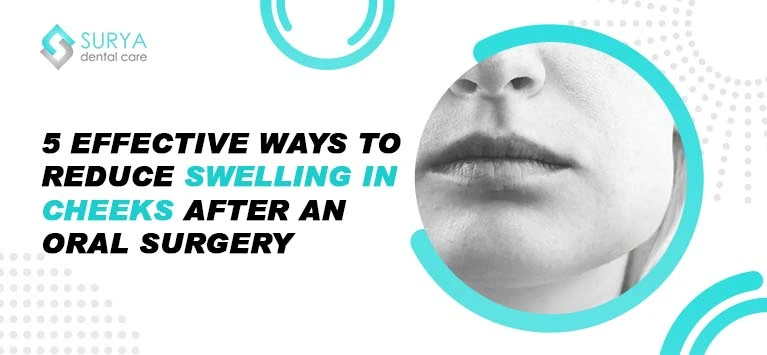Are you dealing with a swollen inside cheek and wondering how to find quick relief? Swelling inside your mouth can be uncomfortable and even painful, making it hard to eat, talk, or smile with confidence.
But don’t worry—there are simple steps you can take right now to ease the swelling and start feeling better fast. You’ll discover easy and effective ways to treat your swollen cheek, so you can get back to your day without the constant discomfort.
Keep reading to learn exactly what you can do today to soothe your cheek and prevent future swelling.

Credit: yaremadental.com
Causes Of Cheek Swelling
Swelling inside the cheek can cause discomfort and worry. Understanding the causes helps in finding the right treatment. Swelling happens when tissues get inflamed or irritated. Various factors can trigger this condition, from minor injuries to infections.
Identifying the cause is important to reduce pain and prevent further problems. Keep reading to learn about the main reasons for cheek swelling.
Injury Or Trauma To The Cheek
A hit or bite inside the cheek can cause swelling. This injury leads to bruises or cuts that swell as they heal. Swelling protects the area while the body repairs the damage.
Infections In The Mouth
Bacterial or viral infections can cause cheek swelling. Common infections include abscesses or cold sores. The body sends white blood cells to fight infection, which causes inflammation.
Allergic Reactions
Allergies to foods or products can cause sudden cheek swelling. The immune system reacts to allergens by releasing chemicals. This reaction leads to redness, swelling, and sometimes itching.
Dental Problems
Tooth decay and gum disease often cause cheek swelling. An infected tooth or gum can swell and become painful. Dental care is important to avoid these issues.
Salivary Gland Blockage
Saliva helps digestion but can cause problems if blocked. A blocked salivary gland causes swelling and discomfort in the cheek. Stones or infections often cause this blockage.
Other Medical Conditions
Certain diseases like mumps cause cheek swelling. These conditions usually involve inflammation of glands or tissues. Proper diagnosis helps treat the underlying cause.

Credit: www.researchgate.net
Symptoms To Watch For
Swelling inside the cheek can cause discomfort and worry. Recognizing the symptoms helps in deciding the right care. Pay close attention to changes inside your mouth. Early signs often guide effective treatment.
Visible Redness And Swelling
Look for any red patches inside the cheek. Swelling may make the area look puffy or larger than usual. These signs often point to irritation or infection.
Pain And Tenderness
Notice if the swollen area hurts when touched or moved. Pain can range from mild to sharp. Tenderness may increase while eating or speaking.
Presence Of Sores Or Ulcers
Check for open sores or small ulcers inside the cheek. These can cause burning or stinging sensations. Sores might delay healing and cause ongoing discomfort.
Difficulty Moving The Cheek
Swelling can limit cheek movement. This makes chewing, talking, or smiling harder. Limited movement signals the need for prompt care.
Other Symptoms To Note
Watch for signs like bad breath, bleeding, or fever. These may indicate a deeper infection. Early detection helps prevent further problems.
Home Remedies To Reduce Swelling
Swelling inside the cheek can cause discomfort and pain. Simple home remedies help reduce this swelling quickly. These methods are easy to follow and use natural ingredients. They can ease pain and help healing.
Cold Compress
Apply a cold compress to the outside of your cheek. Use a clean cloth wrapped around ice or a cold pack. Hold it there for 10 to 15 minutes. This helps reduce swelling and numbs the pain. Repeat every few hours as needed.
Saltwater Rinse
Mix half a teaspoon of salt in a glass of warm water. Swish the saltwater gently in your mouth for 30 seconds. Spit it out and avoid swallowing. Saltwater cleans the mouth and reduces inflammation. Use this rinse 2 to 3 times daily.
Aloe Vera Gel
Apply fresh aloe vera gel directly on the swollen area inside your cheek. Aloe vera has soothing and healing properties. Leave it on for a few minutes, then rinse with water. Repeat this process twice a day for relief.
Diet Tips For Faster Healing
Eating the right foods helps your cheek heal faster. Choosing soft, healthy items reduces pain and swelling. Drinking enough water also speeds recovery.
This section shares diet tips that support healing. These tips focus on easy-to-eat foods and nutrients that repair tissue.
Eat Soft And Moist Foods
Soft foods cause less irritation to your cheek. Try yogurt, mashed potatoes, and soups. Avoid crunchy or spicy foods that can hurt more.
Include Foods Rich In Vitamin C
Vitamin C helps your body build new tissue. Eat fruits like oranges, strawberries, and kiwi. Vegetables like bell peppers and broccoli also have vitamin C.
Stay Hydrated
Water keeps your mouth moist and cleans it. Drink plenty of water throughout the day. Avoid sugary or acidic drinks that may irritate your cheek.
Choose Protein-rich Foods
Protein helps repair damaged cells quickly. Soft options include eggs, tofu, and smooth nut butters. These foods provide building blocks for healing.
Avoid Irritating Substances
Steer clear of spicy, salty, and acidic foods. These can worsen swelling and cause pain. Also, avoid hot drinks until your cheek feels better.
When To Seek Medical Help
Swelling inside the cheek often goes away on its own. Sometimes, home care helps reduce pain and swelling. Yet, some signs mean it is time to see a doctor. Knowing when to seek medical help can prevent serious problems.
Severe Pain That Does Not Ease
Sharp or strong pain lasting more than a day needs attention. Pain that gets worse or stops you from eating or sleeping is a warning. Doctors can find the cause and offer proper treatment.
Swelling That Spreads Or Grows
Swelling moving to other parts of the face or neck is serious. It can block breathing or cause infections. Immediate medical care is important to avoid risk.
Fever With Swollen Cheek
A high fever and swollen cheek together often show infection. This needs quick treatment to stop the illness from spreading. Do not wait if fever is above 101°F (38°C).
Difficulty Opening Mouth Or Swallowing
Problems opening the mouth or swallowing might mean a deep infection. It can cause more harm if untreated. Medical help can diagnose and treat the problem fast.
Swelling Lasting More Than Two Weeks
If swelling stays longer than 14 days, see a doctor. Persistent swelling might mean an underlying health issue. Early diagnosis helps in better treatment and recovery.

Credit: www.suryadentalcare.com
Frequently Asked Questions
What Causes Swelling Inside The Cheek?
Swelling can result from injury, infection, allergies, or irritation from biting the cheek.
How Can I Reduce Cheek Swelling At Home?
Apply a cold compress, rinse with salt water, and avoid spicy foods.
When Should I See A Doctor For Cheek Swelling?
Seek medical help if swelling lasts more than two days or causes severe pain.
Can Allergies Cause Swelling Inside The Cheek?
Yes, allergic reactions to foods or products can cause cheek swelling.
Is Cheek Swelling A Sign Of Infection?
Often yes, infections like abscesses or oral thrush can cause swelling.
What Home Remedies Soothe Swollen Cheeks Quickly?
Cold compress, saltwater rinse, and keeping the mouth clean help reduce swelling fast.
Conclusion
Swelling inside the cheek can cause real discomfort. Treat it early to avoid bigger problems. Use gentle rinses and avoid spicy foods. Keep the area clean and watch for changes. If pain or swelling lasts, see a doctor soon. Taking care of your mouth helps you feel better fast.
Small steps make a big difference in healing. Stay aware of your symptoms and act quickly. Your smile deserves good care every day.
Munia Akondh is a passionate skincare writer with a foundation in life sciences, which gives her a unique scientific perspective on beauty and skincare. As a digital marketer and skincare geek, Munia combines her love for product research, skin health, and marketing to create insightful content that resonates with beauty enthusiasts. Her expertise spans from understanding skincare ingredients to keeping up with the latest trends, making her a trusted voice in the industry.
